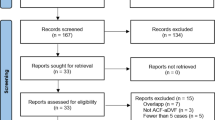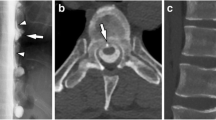Abstract
Cerebrospinal fluid (CSF)-venous fistula can cause spontaneous intracranial hypotension (SIH) and poses a significant diagnostic and management challenge. This study aims to provide a comprehensive overview of the clinical and radiological outcomes of endovascular embolization as a novel treatment approach for CSF-venous fistula in patients with SIH. This systematic review adheres to the Preferred Reporting Items for Systematic Reviews and Meta-Analyses 2020 statement. The primary outcome was the efficacy of the embolization procedure in occlusion of the CSF-venous fistula, and secondary outcomes included procedural complications and improvement of clinical symptoms and radiological findings. A total of nine studies consisting of 77 patients met the inclusion criteria. Orthostatic and/or Valsalva headache was the most common symptom. The mean age of the patients was 57 ± 8.9 years, and females accounted for 59.7% (46/77) of the cases. Sixty-five (84.4%) patients reported complete resolution or significant improvement in symptoms. The Bern score, Headache Impact Test-6, and the Patient Global Impression of Change scales demonstrated significant improvements in radiological findings and patients’ quality of life. Following the procedure, 22 patients (28.6%) experienced rebound intracranial hypertension and 27 patients (35.1%) had transient local pain at the site of the embolization. Our study showed that endovascular embolization is a safe and effective treatment for CSF-venous fistula in patients with SIH, providing complete resolution or significant improvement of clinical symptoms and radiological findings, and positive impacts on patients’ quality of life.

Similar content being viewed by others
Data availability
The data that support the findings of this study are available from the corresponding author, A.O., upon reasonable request.
References
Schievink WI (2013) Stroke and death due to spontaneous intracranial hypotension. Neurocrit Care 18:248–251. https://doi.org/10.1007/s12028-012-9800-3
Schievink WI, Maya MM, Moser FG, Jean-Pierre S, Nuño M (2018) Coma: a serious complication of spontaneous intracranial hypotension. Neurology 90:e1638–e1645. https://doi.org/10.1212/WNL.0000000000005477
Mokri B (2013) Spontaneous low pressure, low CSF volume headaches: spontaneous CSF leaks. Headache 53:1034–1053. https://doi.org/10.1111/head.12149
Kumar R, Cutsforth-Gregory JK, Brinjikji W (2023) Cerebrospinal fluid leaks, spontaneous intracranial hypotension, and Chiari I malformation. Neurosurg Clin N Am 34:185–192. https://doi.org/10.1016/j.nec.2022.08.012
Urbach H, Fung C, Dovi-Akue P, Lützen N, Beck J (2020) Spontaneous intracranial hypotension. Dtsch Arztebl Int 117:480–487. https://doi.org/10.3238/arztebl.2020.0480
Schievink WI, Moser FG, Maya MM (2014) CSF-venous fistula in spontaneous intracranial hypotension. Neurology 83:472–473. https://doi.org/10.1212/WNL.0000000000000639
Schievink WI, Maya M, Prasad RS, Wadhwa VS, Cruz RB, Moser FG, Nuno M (2021) Spontaneous spinal cerebrospinal fluid-venous fistulas in patients with orthostatic headaches and normal conventional brain and spine imaging. Headache 61:387–391. https://doi.org/10.1111/head.14048
Berroir S, Loisel B, Ducros A, Boukobza M, Tzourio C, Valade D, Bousser M-G (2004) Early epidural blood patch in spontaneous intracranial hypotension. Neurology 63:1950–1951. https://doi.org/10.1212/01.wnl.0000144339.34733.e9
Lohkamp L-N, Marathe N, Nicholson P, Farb RI, Massicotte EM (2022) Minimally invasive surgery for spinal cerebrospinal fluid-venous fistula ligation: patient series. J Neurosurg Case Lessons 3:CASE21730. https://doi.org/10.3171/CASE21730
Wang TY, Karikari IO, Amrhein TJ, Gray L (2020) Kranz PG (2020) Clinical outcomes following surgical ligation of cerebrospinal fluid-venous fistula in patients with spontaneous intracranial hypotension: a prospective case series. Oper Neurosurg (Hagerstown) 18(3):239–245. https://doi.org/10.1093/ons/opz134
Mehta D, Cheema S, Davagnanam I, Matharu M (2023) Diagnosis and treatment evaluation in patients with spontaneous intracranial hypotension. Front Neurol 14:1145949. https://doi.org/10.3389/fneur.2023.1145949
Orscelik A, Cutsforth-Gregory JK, Madhavan A, Senol YC, Kobeissi H, Bilgin GB, Bilgin C, Kallmes DF, Brinjikji W. Endovascular embolization techniques for cerebrospinal fluid-venous fistula in the treatment of spontaneous intracranial hypotension. Radiol Clin N Am. https://doi.org/10.1016/j.rcl.2023.10.006
Page MJ, McKenzie JE, Bossuyt PM, Boutron I, Hoffmann TC, Mulrow CD, Shamseer L, Tetzlaff JM, Akl EA, Brennan SE, Chou R, Glanville J, Grimshaw JM, Hróbjartsson A, Lalu MM, Li T, Loder EW, Mayo-Wilson E, McDonald S, McGuinness LA, Stewart LA, Thomas J, Tricco AC, Welch VA, Whiting P, Moher D (2021) The PRISMA 2020 statement: an updated guideline for reporting systematic reviews. BMJ 372:n71. https://doi.org/10.1136/bmj.n71
Sterne JA, Hernán MA, Reeves BC, Savović J, Berkman ND, Viswanathan M, Henry D, Altman DG, Ansari MT, Boutron I, Carpenter JR, Chan A-W, Churchill R, Deeks JJ, Hróbjartsson A, Kirkham J, Jüni P, Loke YK, Pigott TD, Ramsay CR, Regidor D, Rothstein HR, Sandhu L, Santaguida PL, Schünemann HJ, Shea B, Shrier I, Tugwell P, Turner L, Valentine JC, Waddington H, Waters E, Wells GA, Whiting PF, Higgins JP (2016) ROBINS-I: a tool for assessing the risk of bias in non-randomised studies of interventions. BMJ 355:i4919. https://doi.org/10.1136/bmj.i4919
Brinjikji W, Savastano LE, Atkinson JLD, Garza I, Farb R, Cutsforth-Gregory JK (2021) A novel endovascular therapy for CSF hypotension secondary to CSF-venous fistulas. AJNR Am J Neuroradiol 42:882–887. https://doi.org/10.3174/ajnr.A7014
Aljuboori Z, McGrath M, Essibayi MA, Zaidi S, Hallam D (2021) Ghodke B (2021) Spontaneous spinal cerebrospinal fluid venous-fistula treated with transvenous embolization: a case report. Surg Neurol Int 12:492. https://doi.org/10.25259/SNI_878_2021
Borg N, Oushy S, Savastano L, Brinjikji W (2022) Transvenous embolization of a cerebrospinal fluid-venous fistula for the treatment of spontaneous intracranial hypotension. J Neurointerv Surg 14:948. https://doi.org/10.1136/neurintsurg-2021-018160
Brinjikji W, Garza I, Whealy M, Kissoon N, Atkinson JLD, Savastano L, Madhavan A, Cutsforth-Gregory J (2022) Clinical and imaging outcomes of cerebrospinal fluid-venous fistula embolization. J Neurointerv Surg 14:953–956. https://doi.org/10.1136/neurintsurg-2021-018466
Bergui M, Mistretta F, Bosco G, Cester G, Chioffi F, Gambino A, Molinaro S, Russo R, Sorarù G, Causin F (2022) CSF-venous leak responsible for spontaneous intracranial hypotension treated by endovascular venous route: first cases in Italy. Interv Neuroradiol 15910199221116012. https://doi.org/10.1177/15910199221116011
Parizadeh D, Vasconcelos AHC, Miller DA, Fermo OP, Huynh TJ (2022) Dual microcatheter and coil/balloon pressure cooker technique for transvenous embolization of cerebrospinal fluid-venous fistulas. J Neurointerv Surg neurintsurg-2022–019005. https://doi.org/10.1136/neurintsurg-2022-019005
Madhavan AA, Cutsforth-Gregory JK, Oushy SH, Borg N, Brinjikji W (2022) Combined CSF-venous fistula and middle meningeal artery embolization for treatment of spontaneous intracranial hypotension. Interv Neuroradiol 15910199221109044. https://doi.org/10.1177/15910199221109044
Noufal M, Liang CW, Negus J (2022) Transvenous embolization for cerebrospinal fluid-venous fistula. A case series from a single community-academic center. World Neurosurg 168:e613–e620. https://doi.org/10.1016/j.wneu.2022.10.050
Parizadeh D, Fermo O, Vibhute P, Gupta V, Arturo Larco JL, Grewal SS, Quinones-Hinojosa A, Erben YM, Clendenen S, Rozen TD, Huynh TJ (2023) Transvenous embolization of cerebrospinal fluid-venous fistulas: independent validation and feasibility of upper-extremity approach and using dual-microcatheter and balloon pressure cooker technique. J Neurointerv Surg jnis-2022–019946. https://doi.org/10.1136/jnis-2022-019946
Borg N, Cutsforth-Gregory J, Oushy S, Huynh T, Savastano LE, Cloft HJ, Lanzino G, Brinjikji W (2022) Anatomy of spinal venous drainage for the neurointerventionalist: from puncture site to intervertebral foramen. AJNR Am J Neuroradiol 43:517–525. https://doi.org/10.3174/ajnr.A7409
Houk JL, Dennison JV, Kranz PG, Amrhein TJ (2022) Spontaneous intracranial hypotension: a review of pathogenesis, presentation, diagnosis, and treatment. Adv Clin Radiol 4:231–241. https://doi.org/10.1016/j.yacr.2022.04.015
D’Antona L, Jaime Merchan MA, Vassiliou A, Watkins LD, Davagnanam I, Toma AK, Matharu MS (2021) Clinical presentation, investigation findings, and treatment outcomes of spontaneous intracranial hypotension syndrome: a systematic review and meta-analysis. JAMA Neurol 78:329–337. https://doi.org/10.1001/jamaneurol.2020.4799
Schievink WI, Maya M, Barnard Z, Taché RB, Prasad RS, Wadhwa VS, Moser FG, Nuño M (2022) The reversible impairment of behavioral variant frontotemporal brain sagging syndrome: challenges and opportunities. Alzheimers Dement (N Y) 8:e12367. https://doi.org/10.1002/trc2.12367
Timoney R, Bethanabatla R, Reddy M, Taha A (2023) Surgical resolution of severe headache and ataxia caused by spontaneous spinal cerebrospinal fluid leak secondary to cerebrospinal fluid venous fistula—case report. SN Compr Clin Med 5:45. https://doi.org/10.1007/s42399-022-01381-0
Schievink WI, Maya MM, Moser FG, Tuchman A, Cruz RB, Farb RI, Rebello R, Reddy K, Prasad RS (2019) Spontaneous spinal CSF-venous fistulas associated with venous/venolymphatic vascular malformations: report of 3 cases. J Neurosurg Spine 32:305–310. https://doi.org/10.3171/2019.8.SPINE19716
Schievink WI (2021) Spontaneous intracranial hypotension. N Engl J Med 385:2173–2178. https://doi.org/10.1056/NEJMra2101561
Farnsworth PJ, Madhavan AA, Verdoorn JT, Shlapak DP, Johnson DR, Cutsforth-Gregory JK, Brinjikji W, Lehman VT (2023) Spontaneous intracranial hypotension: updates from diagnosis to treatment. Neuroradiology 65:233–243. https://doi.org/10.1007/s00234-022-03079-5
Kranz PG, Gray L, Malinzak MD, Houk JL, Kim DK, Amrhein TJ (2021) CSF-venous fistulas: anatomy and diagnostic imaging. AJR Am J Roentgenol 217:1418–1429. https://doi.org/10.2214/AJR.21.26182
Shlobin NA, Shah VN, Chin CT, Dillon WP, Tan LA (2021) Cerebrospinal fluid-venous fistulas: a systematic review and examination of individual patient data. Neurosurgery 88:931–941. https://doi.org/10.1093/neuros/nyaa558
Schievink WI, Maya MM, Moser FG, Prasad RS, Cruz RB, Nuño M, Farb RI (2019) Lateral decubitus digital subtraction myelography to identify spinal CSF-venous fistulas in spontaneous intracranial hypotension. J Neurosurg Spine 1–4. https://doi.org/10.3171/2019.6.SPINE19487
Shlapak DP, Mark IT, Kim DK, Benson JC, Diehn FE, Kissoon NR, Liebo GB, Madhavan AA, Morris JM, Morris PP, Oien MP, Verdoorn JT, Carr CM (2023) Incremental diagnostic yield and clinical outcomes of lateral decubitus CT myelogram immediately following negative lateral decubitus digital subtraction myelogram. Neuroradiol J 19714009231173110. https://doi.org/10.1177/19714009231173110
Kranz PG, Amrhein TJ, Schievink WI, Karikari IO, Gray L (2016) The “hyperdense paraspinal vein” sign: a marker of CSF-venous fistula. AJNR Am J Neuroradiol 37:1379–1381. https://doi.org/10.3174/ajnr.A4682
Shukla D, Sadashiva N, Saini J, Kamath S (2021) Spontaneous intracranial hypotension—a dilemma. Neurol India 69:S456–S462. https://doi.org/10.4103/0028-3886.332255
Mamlouk MD, Shen PY, Sedrak MF, Dillon WP (2021) CT-guided fibrin glue occlusion of cerebrospinal fluid-venous fistulas. Radiology 299:409–418. https://doi.org/10.1148/radiol.2021204231
Majeed K, Hanz SZ, Roytman M, Chazen JL, Greenfield JP (2021) Identification and surgical ligation of spinal CSF-venous fistula. Surg Neurol Int 12:514. https://doi.org/10.25259/SNI_539_2021
Konovalov A, Gadzhiagaev V, Vinogradov E, Nikitin N, Eliava S, Konovalov N (2022) Surgical treatment efficacy of CSF-venous fistulas: systematic review. World Neurosurg 161:91–96. https://doi.org/10.1016/j.wneu.2022.02.036
Author information
Authors and Affiliations
Contributions
A.O. designed the concept, collected the data, analyzed and interpreted the data, and drafted the paper. Y.C.S. contributed to the scanning process, study selection, and data extraction, and reviewed submitted version of manuscript. B.M. contributed to the scanning process, study selection, and data extraction, and reviewed submitted version of manuscript. H.K. contributed to administrative, technical, and material support, and reviewed submitted version of manuscript. G.B.B. contributed to administrative and technical support, and reviewed submitted version of manuscript. S.Z. contributed to technical support, and reviewed submitted version of manuscript. C.B. reviewed submitted version of manuscript. M.P. reviewed submitted version of manuscript. W.B. designed the concept, interpreted the data, critically revised the paper, supervised, and reviewed submitted version of manuscript. All authors read and approved the final manuscript.
Corresponding author
Ethics declarations
Ethics approval
This systematic review involved the analysis and synthesis of previously published data and information from electronic databases. The study did not involve direct interaction with human participants, the collection of new primary data, or the use of sensitive personal information. As a result, ethical approval was not deemed necessary for this study.
Competing interests
W.B. holds equity in Nested Knowledge, Superior Medical Editors, Piraeus Medical, Sonoris Medical, and MIVI Neurovascular. He receives royalties from Medtronic and Balloon Guide Catheter Technology. He receives consulting fees from Medtronic, Stryker, Imperative Care, MicroVention, MIVI Neurovascular, Cerenovus, Asahi, and Balt. He serves in a leadership or fiduciary role for MIVI Neurovascular, Marblehead Medical LLC, Interventional Neuroradiology (Editor-in-Chief), Piraeus Medical, and WFITN. The remaining authors have no conflicts of interest to declare.
Additional information
Publisher's Note
Springer Nature remains neutral with regard to jurisdictional claims in published maps and institutional affiliations.
Rights and permissions
Springer Nature or its licensor (e.g. a society or other partner) holds exclusive rights to this article under a publishing agreement with the author(s) or other rightsholder(s); author self-archiving of the accepted manuscript version of this article is solely governed by the terms of such publishing agreement and applicable law.
About this article
Cite this article
Orscelik, A., Senol, Y.C., Musmar, B. et al. Endovascular embolization of cerebrospinal fluid-venous fistula: a comprehensive systematic review on its efficacy and safety for the management of spontaneous intracranial hypotension. Neurosurg Rev 47, 28 (2024). https://doi.org/10.1007/s10143-023-02264-1
Received:
Revised:
Accepted:
Published:
DOI: https://doi.org/10.1007/s10143-023-02264-1




